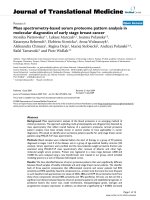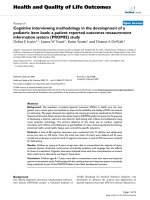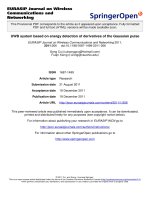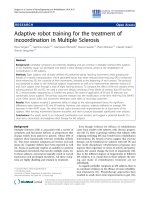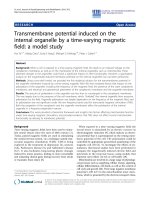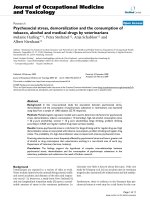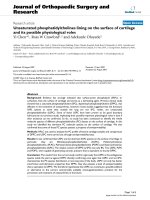Báo cáo hóa học: " Retina identification based on the pattern of blood vessels using fuzzy logic" doc
Bạn đang xem bản rút gọn của tài liệu. Xem và tải ngay bản đầy đủ của tài liệu tại đây (901.48 KB, 8 trang )
RESEARCH Open Access
Retina identification based on the pattern of
blood vessels using fuzzy logic
Wafa Barkhoda
1*
, Fardin Akhlaqian
1
, Mehran Deljavan Amiri
1
and Mohammad Sadeq Nouroozzadeh
2
Abstract
This article proposed a novel human identification method based on retinal images. The proposed system
composed of two main parts, feature extraction component and decision-making component. In feature extraction
component, first blood vessels extracted and then they have been thinned by a morphological algorithm. Then,
two feature vectors are constructed for each image, by utilizing angular and radial partitioning. In previous studies,
Manhattan distance has been used as similarity measure between images. In this article, a fuzzy system with
Manhattan distances of two feature vectors as input and similarity measure as output has been added to decision-
making component. Simulations show that this system is about 99.75% accurate which make it superior to a great
extent versus previous studies. In addition to high accuracy rate, rotation invariance and low computational
overhead are other advantages of the proposed systems that make it ideal for real-time systems.
Keywords: retina images, blood vessels’ pattern, angular partitioning, radial partitioning, fuzzy logic
1. Introduction
Biometric is composed of two Greek roots, Bios is mean-
ing life and Metron is meaning measure. Biometrics
refers to human identification methods which based on
physical or behavioral characteristics. Finger prints, palm
vein, face, iris, retina, voice, DNA and so on are some
examples of these characteristics. In biometric, usually
we use body organs that have simpler and healthier
usage. Each method has its own advantages and disad-
vantages and we could combine them with other security
methods to resolve their drawbacks. These systems have
been designed so that they use people natural character-
istics instead of using keys or ciphers, these characteris-
tics never been lost, robbed, or forgotten, they are
available anytime and anywhere and coping them or for-
ging them are so difficult [1,2].
Characteristics which could be used in biometric s ys-
tem must have two important uniqueness and repeat-
ability properties. This means that the characteristic
must be so that it could recognize all people from each
other and also it must infinitely be measurabl e for all
peoples.
Humans are familiar wit h biometric for a long time
but it become popular in the last two centuries. In 1870,
a French researcher first introduced human identifica-
tion system based on measurement of body skeleton
parts. This system was used in United States until 1920.
Also, in 1880, fingerprint and face were proposed for
human identification. Another usage of biometric goes
back to World War II, when Germans record people’s
fingerprint on their ID. Also retina vessels first have
been used in 1980. Iris image is another biometric that
has been used so far. Although use of them has been
suggested in 1936 but due to technological limitations
they have not been used until 1993.
Biometric features are divided into physical, behavioral,
and chemical categories based on their essence. Using
phy sical characteristics is one of the oldest identification
methods which get more diverse by technological
advancements. Fingerprint, face, iris, and retina are exam-
ples of the most popular physical biometrics. The most
important advantages of this category are their high
uniqueness and their stability over time.
Behavioral techniques evaluate doing of some task by
the user. Signature modes, walking style, or expression
style of some statement are examples of these features.
Moreover, typing or writing style or voice could be classi-
fied as behavioral characteristics too. Lack of stability
* Correspondence:
1
Department of Computer, University of Kurdistan, P.O. Box 416, Sanandaj,
Iran
Full list of author information is available at the end of the article
Barkhoda et al. EURASIP Journal on Advances in Signal Processing 2011, 2011:113
/>© 2011 Barkhoda et al; licensee Springer. This is an Open Access article distributed under the terms of the Creative Commons
Attribu tion License ( which permits unrestricted use, distribution, and reproduction in
any medium, provided the original work is properly cited.
over time is a great drawback of these features because
people’s habits and behaviors are being changed over
time and therefore these characteristics will be changed
accordingly. For resolving this problem, database o f
human features must be updated frequently.
Chemical techniques meas ure chemical properties of
the user’s body like body smell or blood glucose, these
features are not stable in all conditions and situations
therefore they are not dependable so much.
Blood vessel’s pattern of retina is unique among people
and forms a good differentiation between peoples. Owing
to this property retina images could be one of the best
choices for biometric systems. In this article, a novel
human identification system based on retinal images has
been proposed. The proposed system has two main
phases like ot her pattern recognition system; these
phases are feature extraction and decision-making
phases. In feature extraction phase, we extracts feature
vectors for all images of our database by uti lizing angular
and radial partitioning. Then, in decision-making phase,
we compute Manhattan distance of all images with each
other and make final decision using fuzzy system. It is
notedthatwehaveused1DFouriertransformforrota-
tion invariance.
The rest of the article is organized as follows: in Section
2, we investigate retina and corresponding technologies. In
Section 3, we described the proposed algorithms with its
details. Simulation results and comparison of them with
previous studies have been represented in Section 4 and
finally, Section 5 is the conclusion and suggestion for
some future studies.
2. Overview of retinal technology
Retina is one of the most dependable biometric features
because of its natural characteristics and low possibility
of fraud because pattern of human’s retinas rarely
changes during their life and also it is stable and could
not be manipulated. Retina-based identification and
recognition systems have uniqueness and stability prop-
erties because pattern of retina’s vessels is unique and
stable. Despite of these appropriate attributes, retina has
not been used so much in recent decades because of
technological limitations and its expensive corresponding
devices [3-6]. Therefore, a few identification studies
based on retina images have been performed until now
[7-10]. Nowadays, because of various technological
advancements and cheapen of retina scanners, these
restrictions have been eliminated [6,11]. EyeDentify
Company has marketed the first commercial identifica-
tion tool (EyeDentification 7.5) in 1976 [6].
Xu et al. [9] used the green grayscale retinal image
and obtained vector curve of blood vessel skeleton. The
major drawback of this algorithm is its computational
cost, s ince a number of rigid motion parameters should
be computed for all possible correspondences between
the query and enrolled images in the database [12].
They have applied their algo rithm on a database which
consists of 200 different images and obtained zero false
recognition against 38 false rejections.
Farzin et al. [12] have suggested another method
based on wavelet transform. Their proposed system con-
sists of blood vessel segmentation, feature generation,
and feature matching parts. They have evaluated their
system using 60 images of DRIVE [13] and STARE [14]
databases and have reported 99% as the a verage success
rate of their system in identification.
Ortega et al. [10] used a fuzzy circular Hough trans-
form to localize the optical disk (OD) in the retinal
image. Then, they defined feature vectors based on the
ridge endings and bifurcations from vessels obtained
from a crease model of the retinal vessels inside the
OD. The y have used a similar appro ach given in [9] for
pattern matching. Although their algorithm is more effi-
cient than that of [9], they have evaluated their system
using a database which only includes 14 images.
2.1. Anatomy of the retina
The retina covers the inner side at the back of the eye
and it is about 0.5 mm thick [8]. Optical nerve or OD
with about 2 × 1.5 mm across is laid inside the central
partoftheretina.Figure1showsasideviewoftheeye
[15]. Blood vessels form a connected pattern like a tree
with OD as root over the surface of retina. The average
thickness of these vessels is about 250 μm [15].
These vessels form a unique pattern for each people
which could be used for identification. Figure 2 shows
different patterns of the blood vessels for four peoples.
Two studies are more complete and more impressive
among the various studies that have been done about
uniqueness of the people’s blood vessels pattern [12]. I n
1935, Simon and Goldstein [7] first introduced unique-
ness of the pattern of vessels among peoples; they also
Figure 1 Anatomy of the human eye [16].
Barkhoda et al. EURASIP Journal on Advances in Signal Processing 2011, 2011:113
/>Page 2 of 8
have suggested using of retina images for identification
in their subsequent articles. The next study has been
done by Tower in 1950 which showed that pattern of
retina’s blood vessels is different even for twins [16,17].
2.2. The strengths and weaknesses of retinal recognition
Pattern of retina ’ s blood vessels rarely changes during
people’s lives. In addition, retina has not contact with
environment unlike the other biometrics such as finger
print; therefore, it is protected f rom external c hanges.
Moreover, people have not access to their retina and
hence they could not deceive identification systems.
Small size of the feature vector is a nother advantage of
retina to the other biometrics; this property leads to fas-
ter identification and authentication than other bio-
metrics [18].
Despite of its advantag es, use of retina has some disad-
vant ages that limit application of it [12]. People may suf-
fer from eye disea ses like cataract or glauc oma, these
diseases complicate identification task to a great extent.
Also scanning process needs to a lot of cooperation from
the user that could be unfavorable. In addition, retina
images could reveal people diseases like blood pressure;
this maybe unpleasant for people and it could be harmful
for popularity of retina-based identification systems.
3. The proposed system
In thisarticle, we explain a new identification method
based on retina images. In this section, we review the
proposed algorithm and its d etails. We examine simula-
tion results in the next section. These results are
obtained using DRIVE standard database, as we could see
later the proposed system has about 99.75% accuracy.
In addition to its high accuracy, the suggested system
has two other advantages as well. First, it is computa-
tionally inexpensive so it is very favorable for using in
real-time systems. Also the proposed algorithm is resis-
tant to rotation of the images. Rotation invariance is
very important f or retina-based identification systems
because people may turn their head slightly during scan-
ning time. I n the pr oposed algorithm, a suit able resis-
tan ce to the rotation has been formed using 1D Fourier
transform.
As we mentioned earlier, our system composed of two
feature extraction and decision-making components. In
feature extraction phase, two feature vectors are
extracted by angular and radial partitioning. In decision-
making phase, first two Manhat tan distances are
obtained for images and then individual is identified by
utilizing the fuzzy system. We will explain angular and
radial partitioning along w ith the proposed systems and
its parts in the following sections.
3.1. Angular partitioning
Angular sections defined as degree pieces on the Ω
image [19]. Number of pieces is k and the =2π/K
equation is true (see Figure 3).
According to Figure 3, if any rotation has been made
on the image then pixels in section S
i
will be moved to
section S
j
so that Equation 1 will be true.
j =(i + λ) mod K,fori, λ = 0, 1, 2, , K − 1
(1)
Figure 2 Retina images from four different subjects [12].
Figure 3 Angular partitioning.
Barkhoda et al. EURASIP Journal on Advances in Signal Processing 2011, 2011:113
/>Page 3 of 8
Number of edges pixels in each slice considered as a
feature of t hat slice. The scale and translation invariant
image feature is then {f(i)} where
f (i)=
(i +1)2π
K
θ =
i2π
K
R
ρ=0
(ρ, θ )fori = 0, 1, 2, , K − 1
(2)
where R is the radi us of the surrounding circle of the
image.
When the considered image rotates to τ = l2π/K radians
(l = 0, 1, 2, ) then its corresponding feature vector shifts
circularly. To demonstrate this subject, let Ω
τ
as counter
counterclockwise rotated image of Ω to τ radians
τ
(ρ, θ )=(ρ, θ − τ )
(3)
So, the feature element of a considered section will be
obtained from Equation 4.
f
τ
(i)=
(i +1)2π
K
θ =
i2π
K
R
ρ=0
τ
(ρ, θ )
(4)
Also we can express f
τ
as:
f
τ
(i)=
(i +1)2π
K
θ =
i2π
K
R
ρ=0
(ρ, θ − τ)
=
(i − l +1)2π
K
θ =
(i − l)2π
K
R
ρ=0
(ρ, θ )
= f(i − l)
(5)
Since f
τ
(i)=f(i - l) is true, we could conclude that the
feature vector has been circularly shifted.
If we apply 1D Fourier transform to the images, Equa-
tion 6 will be obtained.
F( u)=
1
K
K−1
i=0
f (i) e
−j2πui/K
F
τ
(u)=
1
K
K−1
i=0
f
τ
(i) e
−j2πui/K
=
1
K
K−1
i=0
f (i − l) e
−j2πui/K
=
1
K
K−1−l
i=−l
f (i) e
−j2πu(i+l)/K
= e
−j2πul/K
F( u)
(6)
Based on the property |F(u)| = |F
τ
(u)|, the scale, transla-
tion, and rotation invariant image feature are chosen as Ψ
={|F(u)|} for u =0,1,2, ,K-1. The extracted features are
robust against translatio n because of the aforementioned
normalization process. Choosing a medium-size slice
makes the extracted features more vigorous against local
variations. This is based on the fact that the number of
pixels in such slices varies slowly with local translations.
The features are rotation invariant because of the Fourier
transform applied [19].
3.2. Radial partitioning
In radial partit ioning , the image I is divided into several
concentric circles. The number of circles may be changed
to get to best results. In radial partitioning, features are
deter mined like angular partitioning, it means that we let
the number of the edges pixels in each circle as a feature
element. According to structure of this type of partitioning
and because the centers of circles are one point, local infor-
mation and feature values are not changed if a rotation
happened. Figure 4 s hows an example of radial p artitioning.
3.3. Feature extraction
Figure 5 shows overview of the proposed system’ sfea-
ture extraction part. This process is done for all images
in database and query images.
As one can see from Figure 5 , feature extraction has
some phases. In preprocessing phase, at first, useless mar-
gins are removed and images are limited to the retina’s
edges. Al so in this step, all images are saved in a J × J array.
A sample output of this step is depicted i n Figure 6 b.
Figure 4 Radial partitioning.
Barkhoda et al. EURASIP Journal on Advances in Signal Processing 2011, 2011:113
/>Page 4 of 8
In next step, we must extrac t patterns of blood vessels
from the retina images. Until now, various algorithms and
methods have been suggested for recognition of these pat-
terns; in our system, we have used a method like in [13]
(see Figure 6c). Also we have used a morphological algo-
rithm [20] for thinning the extracted patterns. A sample
output of the morphological algorithm has shown in Figure
6d. In fact we have used only thicker and more significant
vessels for identification and have eliminated thinner ones.
In next step, we generate two separate feature vectors
for each image using angular and radial partitioning simul-
taneously (see Figure 6e, f). The procedure is as follows:
first we partition the image based on type of the partition-
ing and then we let number of sketch pixels within each
section as feature value of that segment. After finishing
this step, we have two feature vectors correspond to angu-
lar and radial partitioning which will be used on decision-
making phase.
3.4. Decision-making phase
Pattern matching is a key point in all pattern-recogni-
tion algorithms. Searching and finding similar images to
a requested image in database is one of the most impor-
tant tasks in image-based identification systems. Feature
Figure 5 Overview of the feature extraction component.
Figure 6 Steps of feature vector extraction in the proposed system. (a) Initial image of the retina. (b) Retina’s image after preprocessing
step. (c) Pattern of blood vessels extracted by the algorithm in [13]. (d) Thinned pattern of vessels using a morphological algorithm. (e) Angular
portioning. (f) Radial partitioning.
Barkhoda et al. EURASIP Journal on Advances in Signal Processing 2011, 2011:113
/>Page 5 of 8
vectors of the query image and images in the database
are compared to each other and nearest image to the
query image returned as a result. In suggested algo-
rithms for pattern matching, various distance criterions
have been used as similarity measure. Manhattan dis-
tance and Euclidian distance are two of the most impor-
tant similarity measures used until now [21-23]. Also
some systems have used weighted Manhattan and Eucli-
dian distances as their similarity measures [24,25].
As we stated in feature extraction section, in the pro-
posed system, two feature vectors have been extracted
for each image by applying angul ar and radial partition-
ing. Applying 1D Fourier transform to the feature vec-
tors could eliminate rotation effects. We used
Manhattan distance as similarity measure between
images. So, compute Manhattan distance between the
query image and all images in database. Since we have
two feature vectors, we have two Manhattan distances
too. In some cases, angular partitioning may be better
and in some other cases radial partitioning work s better.
Thi s means that if we rely only on angular partitioning,
maybewemisjudgeonsomeimagesandviceversa.
Angular partitioning only system gives 98% accuracy
[26] and radial partitioning only system is 91.5% accu-
rate. In previous study [27], for reso lving this problem,
we have used sum of the two Manhattan distances in
our system. So, our similarity measure is as given in
Equation 7.
Distance
Total
= Distance
AP
+ Distance
RP
(7)
Details of this similarity measure computation have
depicted in Figure 7. Finally, we choose nearest database
image to the query image as result. This method has
obtained 98.75% accuracy which is superior to both of
them.
Although using sum of the two distances, we reached
to a better accuracy but summation could not be the
best solution. In this article, we have used a fuzzy sys-
tem in decision-making phase. The obtained distances
of previous step form input of the fuzzy system and the
output is similarity between two i mages. Membership
functions of the input and output variables are showed
in Figures 8 and 9, respectively.
Fuzzy rules of our proposed system are as follow.
1. If (AP is Low) and (RP is Low) then (Similarity is
High)
2. If (AP is Lo w) and (RP is Medium) the n (Similar-
ity is High)
3. If (AP is Low) and (RP is High) then (Similarity is
Medium)
4. If (AP is Medium) and (RP is Low) then (Similar-
ity is High)
5. If (AP is Medium) and (RP is Medium) then
(Similarity is Low)
6. If (AP is Medium) and (RP is High) then (Similar-
ity is Low)
7. If (AP is High) and (RP is Low) then (Similarity is
Medium)
8. If (AP is High) and (RP is Medium) then (Similar-
ity is Low)
9. If (AP is High) and (RP is High) then (Similarity is
Low)
It is noted that we have mapped Manhattan distances
to the range of [0 1000]. The value of the output is in
the range [0 1], when the value is close to 1 it means
that two images are very similar. Finally, we consider
closest image to the query image as result. Using this
fuzzy system, we reached to 99.75 accuracy that is
superior to previous studies.
4. Simulation results
The proposed system is implemented on MATLAB plat-
form and has been tested on DRIVE [13] standard data-
base. The DRIVE database contains retina images of 40
people. In our simulations, we have set image sizes to
512 × 512 (J = 512). We have teste d different angles for
performing angular partitioning and finally we conclude
that 5-degree angle produces better results. Therefore,
each image has divided into 72 pieces (360°/5° = 72) and
its corresponding feature vector has 72 elements. On the
Figure 7 Decision making component used in [27].
Barkhoda et al. EURASIP Journal on Advances in Signal Processing 2011, 2011:113
/>Page 6 of 8
other hand in radial partitioning, we have divided the
circle into eight concentric c ircles, so the achieved fea-
ture vector has eight elements. We rotated each image
11 times to generate 440 images. Simulation results
have been demonstrated in Table 1.
Also, proposed system experimented against scale and
rotation variations. First, images rotated on arbitrary
degrees and then these new images are used as system
input (results shown in Table 2).
Then, different scales of images used as input and sys-
tem performance were experimented. Result s have been
shown in Table 3.
5. Conclusion and future works
We have proposed an identification system based on
retina image in thisarticle. The suggested system uses
angular and radial partitioning for feature extraction.
After feature extraction step, Manhattan distances
between the query image and database images are com-
puted and final decision is made based on the proposed
fuzzy system. Simulation results show high accuracy of
our system in comparison with similar systems. More
over rotation invariance and low computational over-
head are other advantages of system that make it suita-
ble for use in real-time systems.
As mentioned earlier, the best results obtained when
we used 5-degree angle for angular partitioning. We
could use other angles as well so we may have different
feature vectors with different lengths for each image.
Hence, we can generate various feature vectors for
images and use them to train a neural network. Then,
we can use the trained neural network for decision mak-
ing. Use of neural network for improving results will be
considered in future studies.
Figure 8 Membership function of input variables.
Figure 9 Membership function of output variable.
Table 1 Simulation results along with results of other
studies
Method Accuracy rate
Radial partitioning 91.5
Angular partitioning 98
Angular and radial partitioning 98.75
Farzin et al. [12] 99
The proposed method 99.75
Barkhoda et al. EURASIP Journal on Advances in Signal Processing 2011, 2011:113
/>Page 7 of 8
Author details
1
Department of Computer, University of Kurdistan, P.O. Box 416, Sanandaj,
Iran
2
Department of Computer, Isfahan University of Technology, Isfahan,
Iran
Competing interests
The authors declare that they have no competing interests.
Received: 2 July 2011 Accepted: 23 November 2011
Published: 23 November 2011
References
1. A Jain, R Bolle, S Pankanti, Biometrics: Personal Identification in a Networked
Society (Kluwer Academic Publishers, Dordrecht, The Netherlands, 1999)
2. D Zhang, Automated Biometrics: Technologies and Systems (Kluwer Academic
Publishers, Dordrecht, Netherlands, 2000)
3. RB Hill, Rotating beam ocular identification apparatus and method. US
Patent 4393366 (1983)
4. RB Hill, Fovea-centered eye fundus scanner. US Patent 4620318 (1986)
5. JC Johnson, RB Hill, Eye fundus optical scanner system and method. US
Patent 5532771 (1990)
6. RB Hill, in Biometrics: Personal Identification in Networked Society, ed. by Jain
A, Bolle R, Pankati S (Springer, Berlin, 1999), p. 126
7. C Simon, I Goldstein, A new scientific method of identification. N Y J Med.
35(18), 901–906 (1935)
8. H Tabatabaee, A Milani Fard, H Jafariani, A novel human identifier system
using retina image and fuzzy clustering approach, in Proceedings of the 2nd
IEEE International Conference on Information and Communication
Technologies (ICTTA ‘06), Damascus, Syria, 1031–1036 (2006)
9. ZW Xu, XX Guo, XY Hu, X Cheng, The blood vessel recognition of ocular
fundus, in Proceedings of the 4th International Conference on Machine
Learning and Cybernetics (ICMLC ‘ 05), Guangzhou, China, 4493–4498 (2005)
10. M Ortega, C Marino, MG Penedo, M Blanco, F Gonzalez, Biometric
authentication using digital retinal images, in Proceedings of the 5th WSEAS
International Conference on Applied Computer Science (ACOS ‘06), Hangzhou,
China, 422–427 (2006)
11. />12. H Farzin, HA Moghaddam, MS Moin, A novel retinal identification system.
EURASIP J Adv Signal Process. 2008(280635) (2008)
13. J Staal, MD Abramoff, M Niemeijer, MA Viergever, B van Ginneken, Ridge-
based vessel segmentation in color images of the retina. IEEE Trans Med
Imag. 23(4), 501–509 (2004). doi:10.1109/TMI.2004.825627
14. A Hoover, V Kouznetsova, M Goldbaum, Locating blood vessels in retinal
images by piecewise threshold probing of a matched filter response. IEEE
Trans Med Imag. 19(3), 203–210 (2000). doi:10.1109/42.845178
15. KG Goh, W Hsu, ML Lee, Medical Data Mining and Knowledge Discovery,
(Springer, Berlin, Germany, 2000), pp. 181–210
16. S Chaudhuri, S Chatterjee, N Katz, M Nelson, M Goldbaum, Detection of
blood vessels in retinal images using two-dimensional matched filters. IEEE
Trans Med Imag. 8(3), 263–269 (1989). doi:10.1109/42.34715
17. P Tower, The fundus oculi in monozygotic twins: report of six pairs of
identical twins. Arch Ophthalmol. 54 (2), 225–239 (1955). doi:10.1001/
archopht.1955.00930020231010
18. WS Chen, KH Chih, SW Shih, CM Hsieh, Personal identification technique
based on human Iris recognition with wavelet transform, in Proceedings of
IEEE International Conference on Acoustics, Speech and Signal Processing
(ICASSP ‘05), vol. 2. Philadelphia, PA, USA, 949–952 (2005)
19. A Chalechale, Content-based retrieval from image databases using sketched
queries. PhD thesis, School of Electrical, Computer, and Telecommunication
Engineering, University of Wollongong (2005)
20. RC Gonzalez, RE Woods, Digital Image Processing (Addison-Wesley, 1992)
21. G Pass, R Zabih, Histogram refinement for content-based image retrieval. in
Proceedings 3rd IEEE Workshop on Applications of Computer Vision,96–102
(1996)
22. A Del Bimbo, Visual Information Retrieval (Morgan Kaufmann Publishers,
1999)
23. CE Jacobs, A Finkelstein, DH Salesin, Fast multiresolution image querying. in
Proceedings ACM Computer Graphics (IGGRAPH 95), USA, 277–286 (1995)
24. M Bober, MPEG-7 Visual shape description. IEEE Trans Circ Syst Video
Technol. 11(6), 716–719 (2001). doi:10.1109/76.927426
25. CS Won, DK Park, S Park, Efficient use of MPEG-7 edge histogram descriptor.
Etri J. 24(1), 23–30 (2002). doi:10.4218/etrij.02.0102.0103
26. W Barkhoda, FA Tab, MD Amiri, Rotation invariant retina identification
based on the sketch of vessels using angular partitioning, in Proceedings
International Multiconference on Computer Science and Information
Technology (IMCSIT’09), Mragowo, Poland, 3–6 (2009)
27. MD Amiri, FA Tab, W Barkhoda, Retina identification based on the pattern
of blood vessels using angular and radial partitioning, in Proceedings
Advanced Concepts for Intelligent Vision Systems (ACIVS 2009), LNCS 5807,
Bordeaux, France, 732–739 (2009)
doi:10.1186/1687-6180-2011-113
Cite this article as: Barkhoda et al.: Retina identification based on the
pattern of blood vessels using fuzzy logic. EURASIP Journal on Advances
in Signal Processing 2011 2011:113.
Submit your manuscript to a
journal and benefi t from:
7 Convenient online submission
7 Rigorous peer review
7 Immediate publication on acceptance
7 Open access: articles freely available online
7 High visibility within the fi eld
7 Retaining the copyright to your article
Submit your next manuscript at 7 springeropen.com
Table 2 Proposed system’s results after rotation
Rotation degree 3 7 10 15 20 30 40 45 67 90 120 153 250 Average
Accuracy rate 100 100 100 100 100 100 100 100 99.45 100 100 98.82 100 99.87
Table 3 Proposed system’s results after size variation
Image size 64 × 64 128 × 128 171 × 171 256 × 256 384 × 384 512 × 512 Average
Accuracy rate 100 100 100 100 100 100 100
Barkhoda et al. EURASIP Journal on Advances in Signal Processing 2011, 2011:113
/>Page 8 of 8
